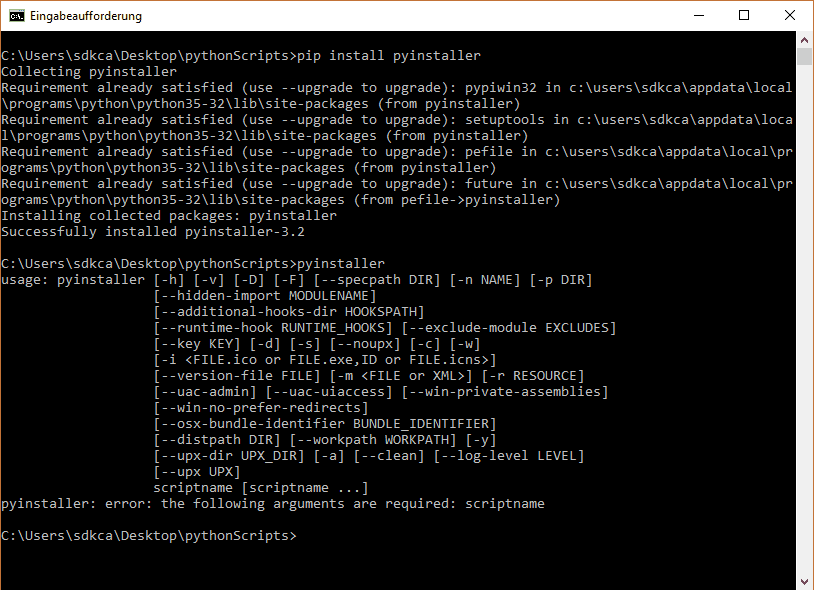Mac OS X has installed python by default, but the version is 2.7.10. It is a little older, so I upgrade python to a newer version ( python 3.7 or python 3.9 ). But after installing the new version, when I open a terminal and run python command, it still uses Python 2.7. This article will tell you how to fix it. If that’s the case, simply run this command instead and it will install pip. Sudo easyinstall pip. Python 2 vs Python 3. Python 2 is still on your system even though you’ve installed Python 3. In order to send commands to Python 3, you will need to enter python3 in the terminal. If you enter python, the command will be sent to Python 2. Jun 13, 2018 Python is a popular programming language that is widely used by beginners and longtime developers alike. Modern Mac OS versions come with Python 2.7.x installed (or Python 2.6.1 if an older Mac OS X version), but many Python users may need to update Python in Mac OS to a newer version like Python 3.8.x or newer. Mac Os X Install Pip For Python3; Mac Os X Pip Command Not Found; Author. Bob Savage Python on a Macintosh running Mac OS X is in principle very similar to Python onany other Unix platform, but there are a number of additional features such asthe IDE and the Package Manager that are worth pointing out.
First, follow the installation instructions for Chocolatey.It’s a community system packager manager for Windows 7+. (It’s very much like Homebrew on OS X.)
Once done, installing Python 3 is very simple, because Chocolatey pushes Python 3 as the default.
Once you’ve run this command, you should be able to launch Python directly from to the console.(Chocolatey is fantastic and automatically adds Python to your path.)
Setuptools + Pip¶
The two most crucial third-party Python packages are setuptools and pip,which let you download, install and uninstall any compliant Python softwareproduct with a single command. It also enables you to add this network installationcapability to your own Python software with very little work.
All supported versions of Python 3 include pip, so just make sure it’s up to date:
Pipenv & Virtual Environments¶
The next step is to install Pipenv, so you can install dependencies and manage virtual environments.
A Virtual Environment is a tool to keep the dependencies required by different projectsin separate places, by creating virtual Python environments for them. It solves the“Project X depends on version 1.x but, Project Y needs 4.x” dilemma, and keepsyour global site-packages directory clean and manageable.
For example, you can work on a project which requires Django 2.0 while alsomaintaining a project which requires Django 1.8.
So, onward! To the Pipenv & Virtual Environments docs!
This page is a remixed version of another guide,which is available under the same license.
Question or problem about Python programming:
OS X (Mavericks) has Python 2.7 stock installed. But I do all my own personal Python stuff with 3.3. I just flushed my 3.3.2 install and installed the new 3.3.3. So I need to install pyserial again. I can do it the way I’ve done it before, which is:
But I’d like to do like the cool kids do, and just do something like pip3 install pyserial. But it’s not clear how I get to that point. And just that point. Not interested (unless I have to be) in virtualenv yet.
How to solve the problem:
Solution 1:
UPDATE: This is no longer necessary with Python3.4. It installs pip3 as part of the stock install.
I ended up posting this same question on the python mailing list, and got the following answer:
Which solved my question perfectly. After adding the following for my own:
So that I could run pip directly, I was able to:
or:
Solution 2:
I had to go through this process myself and chose a different way that I think is better in the long run.
I installed homebrew
then:

The last step gives you some warnings and errors that you have to resolve. One of those will be to download and install the Mac OS X command-line tools.
Os X Pip For Python 3 Download
then:
This gave me python3 and pip3 in my path.
Solution 3:
Install Python3 on mac
Use pip3 to install modules
🙂
Solution 4:

Plus:
when you install requests with python3, the command is:
not
Solution 5:
Here is my simple solution:
If you have python2 and python3 both installed in your system, the pip upgrade will point to python2 by default. Hence, we must specify the version of python(python3) and use the below command:
Install Pip Python 2

This command will uninstall the previously installed pip and install the new version- upgrading your pip.
This will save memory and declutter your system.